
Okeanos Explorer (EX1803): Gulf of Mexico (ROV and Mapping)
Vessel: NOAA Ship Okeanos Explorer; Expedition Dates: April 11, 2018 to May 03, 2018
Ports: Pascagoula, MS to Key West, FL
Project Principals: Nikolai Pawlenko, NOAA/OAR/OER (Expedition Coordinator); Michael White, NOAA/OAR/OER (Mapping Lead)
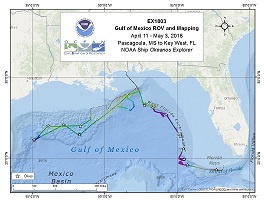
Operations will include the use of the ship's deep water mapping systems (Kongsberg EM302 multibeam sonar, EK60 split-beam fisheries sonars, Knudsen 3260 chirp sub-bottom profiler sonar, and Teledyne Acoustic Doppler Current Profiler), XBT and CTD casts in support of multibeam sonar mapping operations, OER's two-body ROV Deep Discoverer and Seirios, and the ship's high-bandwidth satellite connection for continuous real-time ship-to-shore communications. Operations are planned in and around the US Gulf of Mexico and potentially the international waters of the Gulf.
Expedition Data and Resources
| Ship Navigation Data (ASCII) | Download | Use zip utility to open file |
| Ship SCS/Sensor Data (ASCII) | Download | Use zip utility to open file |
| Ship SCS/Sensor Data (NetCDF) | Open | NetCDF file format: Special software needed to read |
| Shipboard CTDs | Download | Use zip utility to open file |
| Mapping Products | Download | Use zip utility to open file |
| GIS Products | Download | Use zip utility to open file |
Submersible Data and Resources
| Dive Track KMLs | Download | Use zip utility to open file |
| Event Logs | Open | Click to open link |
| Cruise Video Collection Self-Service Portal | Open | Click to open link |
| Collected Specimens | Open | Click to open link |
| Submersible Navigation/Sensor Data (ASCII) | Download | Use zip utility to open file |
Collected Specimen Repositories
| Smithsonian Institution's National Museum of Natural History Research and Collections (Biological Samples) | Open | Click to visit repository website |
| Ocean Genome Legacy Center (OGL) at Northeastern University | Open | Click to visit repository website |
| Oregon State University's Marine Geology Repository | Open | Click to visit repository website |
Educational Resources
| Expedition Education Module | Open | Click to open Education Module |
| Lesson Plans (K-12) | Open | Click to open Lesson Plans |
| Education Materials Collection | Open | Click to open Education Materials |
Links to Archived Data and Resources
| Multibeam Archive Collection | Get Data | Click to Access Archive |
| Water Column Sonar Archive Collection | Get Data | Click to Access Archive |
| Trackline Data (Single-beam and Sub-bottom) | Get Data | Click to Access Archive |
| Physical, Chemical, and Biological Archive Collection | Get Data | Click to Access Archive |
| Expedition Metadata | Open | Click to view Metadata in xml format |
BOEM Shipwreck 15445
Area
BOEM Shipwreck 15445; Gulf of Mexico
Overview
| Date: | April 12, 2018 |
| Max Depth: | n/a |
| Bottom Time: | n/a |
Purpose
n/a
Download & View Files
| Dive Video Collection Self-Service Portal | Open | Link takes you to an online video discovery and access tool |
BOEM Shipwreck 15572
Area
BOEM Shipwreck 15572; Gulf of Mexico
Overview
| Date: | April 13, 2018 |
| Max Depth: | n/a |
| Bottom Time: | n/a |
Purpose
n/a
Download & View Files
| Dive Video Collection Self-Service Portal | Open | Link takes you to an online video discovery and access tool |
Unnamed Ridge in GC973
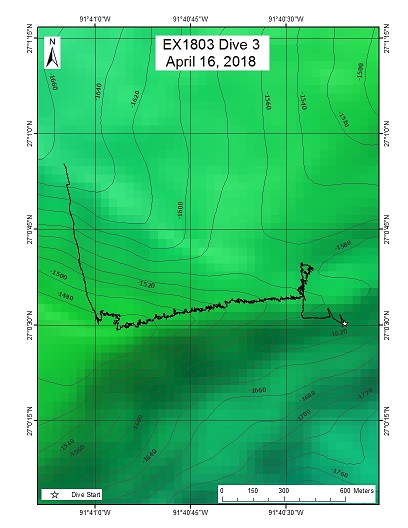
Area
Unnamed Ridge in GC973; Gulf of Mexico
Overview
| Date: | April 16, 2018 |
| Max Depth: | 1574 Meters |
| Bottom Time: | 5 Hours 47 Minutes 20 Seconds |
Purpose
Dive 3 targeted GC973, an area of the Western Gulf of Mexico that has never before been explored using deep-sea submersibles. Specifically, Dive 3 targeted an unnamed ridge in GC973, in hopes of finding exposed substrate and associated biological communities. The closest historical dives to the site, four 2010 surveys by HOV Alvin, were all conducted over 35 km to the east in Orcas Basin. Therefore, this dive was highly exploratory in nature with its main purpose being to explore the ridge for deep-sea corals, sponges, and associated fauna. The target start point of the dive was a flat area at 1584 m. The ROV would then move south up a ~15 degree slope until reaching a depth of ~1560 m. At this point, the ROV would move west parallel to the ridge exploring the ridge for biological communities.
Download & View Files
| Dive Summary Report (PDF - 921 KB) | View/Download | Requires Adobe Acrobat Reader to view the Dive Summary Report |
| Dive Track (KML - 67 KB) | View/Download | Requires Google Earth or equivalent client to view the Dive Track |
| ROV Ancillary Data (Zip - 3.75 MB) | Download | Link takes you to a public FTP server |
| ROV CTD/Sensor Data (Zip - 5.85 MB) | Download | Link takes you to a public FTP server |
| Camera Platform Sensor Data (Zip - 16.8 MB) | Download | Link takes you to a public FTP server |
| Low-Resolution Video Clips (Zip - 10.9 GB) | Download | Link takes you to a public FTP server |
| Underwater Still Images (Zip - 80.3 MB) | Download | Link takes you to a public FTP server |
| Dive Video Collection Self-Service Portal | Open | Link takes you to an online video discovery and access tool |
Unnamed mound in EB 1009
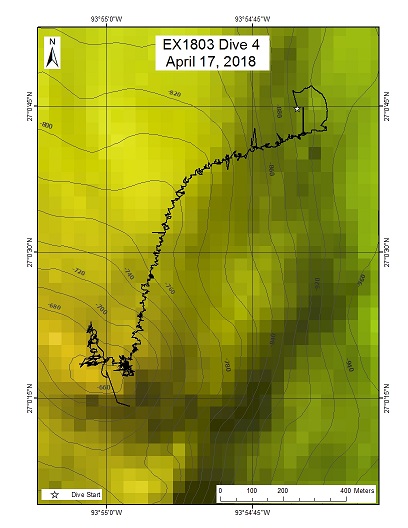
Area
Unnamed mound in EB 1009; Gulf of Mexico
Overview
| Date: | April 17, 2018 |
| Max Depth: | 898 Meters |
| Bottom Time: | 7 Hours 5 Minutes 51 Seconds |
Purpose
Dive 4 targeted EB 1009, an area of the Gulf of Mexico that has never before been explored using deep-sea submersibles. The closest historical dive to the site, a single 2009 survey by AUV Sentry, was conducted over 12 km to the north in GB 837. Therefore, this dive was highly exploratory in nature, and its main purpose was to survey the area for hard-bottom communities, particularly deep-sea corals, sponges, and associated fauna. The target dive site showed very high habitat suitability for framework-building corals in models developed for the Gulf of Mexico (Kinlan et al. 2013). Furthermore, the area also contained several positive anomalies in the seafloor seismic amplitude map developed for the Gulf (BOEM 2017), indicating that it likely contains hard substrate. Thus, besides exploring a poorly known region of the Gulf of Mexico, observations collected during this dive would also help ground-truth existing models for deep-sea coral habitat suitability and seafloor seismic anomalies.
Download & View Files
| Dive Summary Report (PDF - 1.1 MB) | View/Download | Requires Adobe Acrobat Reader to view the Dive Summary Report |
| Dive Track (KML - 66.7 KB) | View/Download | Requires Google Earth or equivalent client to view the Dive Track |
| ROV Ancillary Data (Zip - 4.04 MB) | Download | Link takes you to a public FTP server |
| ROV CTD/Sensor Data (Zip - 6.16 MB) | Download | Link takes you to a public FTP server |
| Camera Platform Sensor Data (Zip - 17.4 MB) | Download | Link takes you to a public FTP server |
| Low-Resolution Video Clips (Zip - 11.8 GB) | Download | Link takes you to a public FTP server |
| Underwater Still Images (Zip - 71.8 MB) | Download | Link takes you to a public FTP server |
| Dive Video Collection Self-Service Portal | Open | Link takes you to an online video discovery and access tool |
North Wall of Perdido Canyon / AC 813
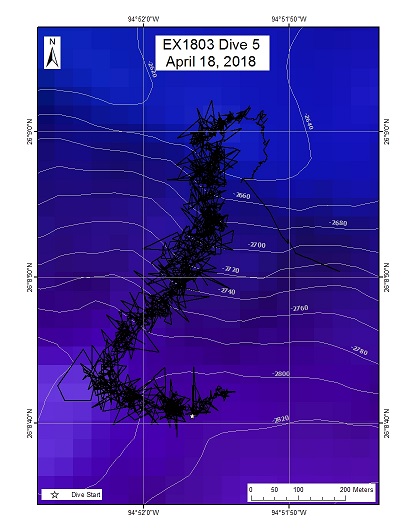
Area
North Wall of Perdido Canyon / AC 813; Gulf of Mexico
Overview
| Date: | April 18, 2018 |
| Max Depth: | 2797 Meters |
| Bottom Time: | 4 Hours 40 Minutes 0 Seconds |
Purpose
The purpose of Dive 5 was to survey the biology and geology of the north wall of Perdido Canyon, a submarine canyon that has never before been explored using deep-sea submersibles by the scientific community. The closest scientific dives to the site, two 2006 surveys by AUV Alvin, were conducted in Alaminos Canyon close to 25 km to the east. Therefore, this dive sought to provide important baseline information about an unexplored deep-sea canyon. Submarine canyons are generally regarded as hotspots of abundance and biodiversity, but have been particularly undersurveyed in many remote and offshore locations like the Western Gulf of Mexico.
Download & View Files
| Dive Summary Report (PDF - 779 KB) | View/Download | Requires Adobe Acrobat Reader to view the Dive Summary Report |
| Dive Track (KML - 67.9 KB) | View/Download | Requires Google Earth or equivalent client to view the Dive Track |
| ROV Ancillary Data (Zip - 3.81 MB) | Download | Link takes you to a public FTP server |
| ROV CTD/Sensor Data (Zip - 6 MB) | Download | Link takes you to a public FTP server |
| Camera Platform Sensor Data (Zip - 17.5 MB) | Download | Link takes you to a public FTP server |
| Low-Resolution Video Clips (Zip - 11.1 GB) | Download | Link takes you to a public FTP server |
| Underwater Still Images (Zip - 98.2 MB) | Download | Link takes you to a public FTP server |
| Dive Video Collection Self-Service Portal | Open | Link takes you to an online video discovery and access tool |
Hidalgo Basin / GB 903
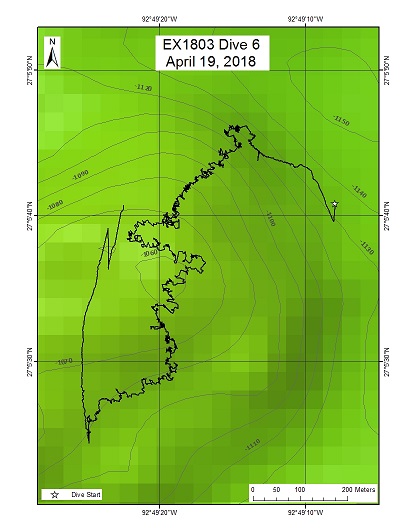
Area
Hidalgo Basin / GB 903; Gulf of Mexico
Overview
| Date: | April 19, 2018 |
| Max Depth: | 1104 Meters |
| Bottom Time: | 5 Hours 59 Minutes 10 Seconds |
Purpose
Dive 6 targeted Hidalgo Basin (GB903), an area that this currently being considered for expansion of the Flower Garden Banks National Marine Sanctuary (FGBNMS) under alternative 5. Specifically, the purpose of Dive 6 was to explore a mound feature for hard-bottom communities, particularly deep-sea corals, sponges and associated fauna. There have been three previous scientific dives in this general area, all of which surveyed a mound feature located ~1.5 km south of the Dive 6 target area, and recorded deep-sea corals and chemosynthetic communities. Thus, the Dive 6 site was chosen to avoid spatial overlap with previous surveys in the area, while still collecting valuable information for the Sanctuary.
Download & View Files
| Dive Summary Report (PDF - 1.23 MB) | View/Download | Requires Adobe Acrobat Reader to view the Dive Summary Report |
| Dive Track (KML - 67.2 KB) | View/Download | Requires Google Earth or equivalent client to view the Dive Track |
| ROV Ancillary Data (Zip - 3.9 MB) | Download | Link takes you to a public FTP server |
| ROV CTD/Sensor Data (Zip - 5.66 MB) | Download | Link takes you to a public FTP server |
| Camera Platform Sensor Data (Zip - 16.3 MB) | Download | Link takes you to a public FTP server |
| Low-Resolution Video Clips (Zip - 10.6 GB) | Download | Link takes you to a public FTP server |
| Underwater Still Images (Zip - 147 MB) | Download | Link takes you to a public FTP server |
| Dive Video Collection Self-Service Portal | Open | Link takes you to an online video discovery and access tool |
Mud volcano in WR 488
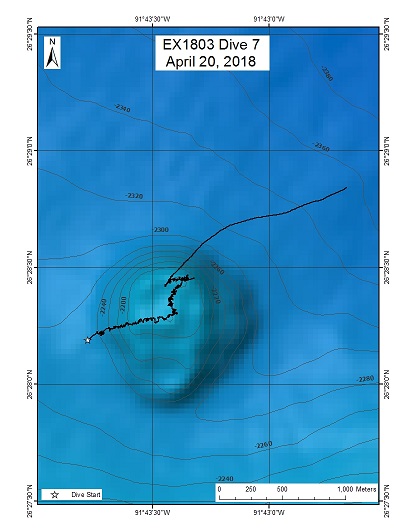
Area
Mud volcano in WR 488; Gulf of Mexico
Overview
| Date: | April 20, 2018 |
| Max Depth: | 2249 Meters |
| Bottom Time: | 5 Hours 34 Minutes 31 Seconds |
Purpose
The purpose of the dive was to survey the geology and biology of a mud volcano in WR 488, an area that has never before been surveyed using deep-sea submersibles by the scientific community. The closest scientific dive survey, a single 2006 HOV Alvin dive, was conducted in WR 269 over 26 km to the north. The dive target area contained positive anomalies in the seafloor seismic amplitude map developed for the Gulf (BOEM 2017), indicating that it might contain some hard substrate. Overnight backscatter mapping data collected by NOAA Ship Okeanos Explorer at the site showed hard returns in the center of the mud volcano, further indicating that it might contain exposed substrate.
Download & View Files
| Dive Summary Report (PDF - 1.08 MB) | View/Download | Requires Adobe Acrobat Reader to view the Dive Summary Report |
| Dive Track (KML - 68.5 KB) | View/Download | Requires Google Earth or equivalent client to view the Dive Track |
| ROV Ancillary Data (Zip - 4.13 MB) | Download | Link takes you to a public FTP server |
| ROV CTD/Sensor Data (Zip - 6.21 MB) | Download | Link takes you to a public FTP server |
| Camera Platform Sensor Data (Zip - 18 MB) | Download | Link takes you to a public FTP server |
| Low-Resolution Video Clips (Zip - 12.6 GB) | Download | Link takes you to a public FTP server |
| Underwater Still Images (Zip - 70.9 MB) | Download | Link takes you to a public FTP server |
| Dive Video Collection Self-Service Portal | Open | Link takes you to an online video discovery and access tool |
Northern West Florida Escarpment, DeSoto Canyon region
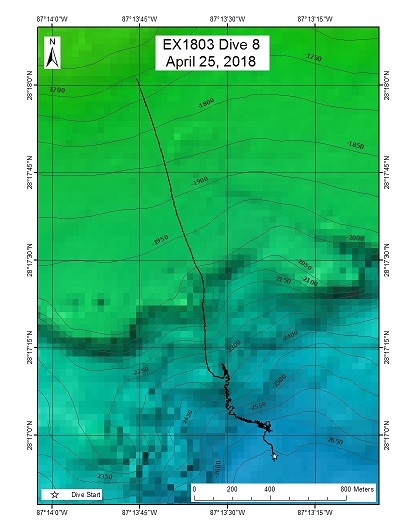
Area
Northern West Florida Escarpment, DeSoto Canyon region; Gulf of Mexico
Overview
| Date: | April 25, 2018 |
| Max Depth: | 2635 Meters |
| Bottom Time: | 5 Hours 25 Minutes 7 Seconds |
Purpose
The purpose of the dive was to survey the geology and biology of a mud volcano in WR 488, an area that has never before been surveyed using deep-sea submersibles by the scientific community. The closest scientific dive survey, a single 2006 HOV Alvin dive, was conducted in WR 269 over 26 km to the north. The dive target area contained positive anomalies in the seafloor seismic amplitude map developed for the Gulf (BOEM 2017), indicating that it might contain some hard substrate. Overnight backscatter mapping data collected by NOAA Ship Okeanos Explorer at the site showed hard returns in the center of the mud volcano, further indicating that it might contain exposed substrate.
Download & View Files
| Dive Summary Report (PDF - 1.32 MB) | View/Download | Requires Adobe Acrobat Reader to view the Dive Summary Report |
| Dive Track (KML - 67.5 KB) | View/Download | Requires Google Earth or equivalent client to view the Dive Track |
| ROV Ancillary Data (Zip - 4.34 MB) | Download | Link takes you to a public FTP server |
| ROV CTD/Sensor Data (Zip - 5.72 MB) | Download | Link takes you to a public FTP server |
| Camera Platform Sensor Data (Zip - 17.5 MB) | Download | Link takes you to a public FTP server |
| Low-Resolution Video Clips (Zip - 11.6 GB) | Download | Link takes you to a public FTP server |
| Underwater Still Images (Zip - 198 MB) | Download | Link takes you to a public FTP server |
| Dive Video Collection Self-Service Portal | Open | Link takes you to an online video discovery and access tool |
North West Florida Escarpment, DeSoto Canyon region (DC862)
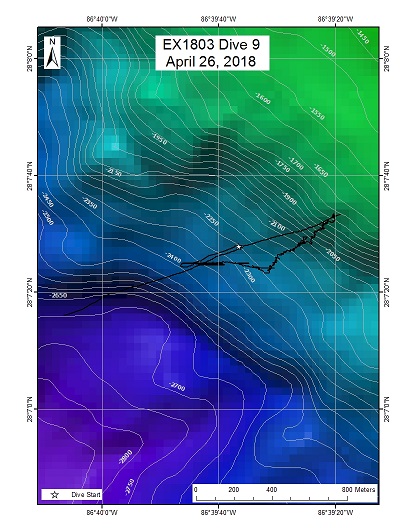
Area
North West Florida Escarpment, DeSoto Canyon region (DC862); Gulf of Mexico
Overview
| Date: | April 26, 2018 |
| Max Depth: | 2261 Meters |
| Bottom Time: | 5 Hours 26 Minutes 31 Seconds |
Purpose
The purpose of Dive 9 was to survey the biology and geology in the northern end of the West Florida Escarpment in the De Soto Canyon region. This area is approximately 60 km east of the area explored during Dive 8 and completely unexplored, with the closest historical dive being conducted over 25 km away. The Dive 9 target area shows very high habitat suitability for antipatharian corals in models developed for the Gulf of Mexico (Kinlan et al. 2013). Thus, besides exploring a poorly known region of the Gulf of Mexico, observations collected during this dive would also help ground-truth existing models for deep-sea coral habitat suitability.
Download & View Files
| Dive Summary Report (PDF - 1.08 MB) | View/Download | Requires Adobe Acrobat Reader to view the Dive Summary Report |
| Dive Track (KML - 67.7 KB) | View/Download | Requires Google Earth or equivalent client to view the Dive Track |
| ROV Ancillary Data (Zip - 3.96 MB) | Download | Link takes you to a public FTP server |
| ROV CTD/Sensor Data (Zip - 5.58 MB) | Download | Link takes you to a public FTP server |
| Camera Platform Sensor Data (Zip - 16.6 MB) | Download | Link takes you to a public FTP server |
| Low-Resolution Video Clips (Zip - 11.6 GB) | Download | Link takes you to a public FTP server |
| Underwater Still Images (Zip - 135 MB) | Download | Link takes you to a public FTP server |
| Dive Video Collection Self-Service Portal | Open | Link takes you to an online video discovery and access tool |
North West Florida Escarpment, DeSoto Canyon region (DC862)
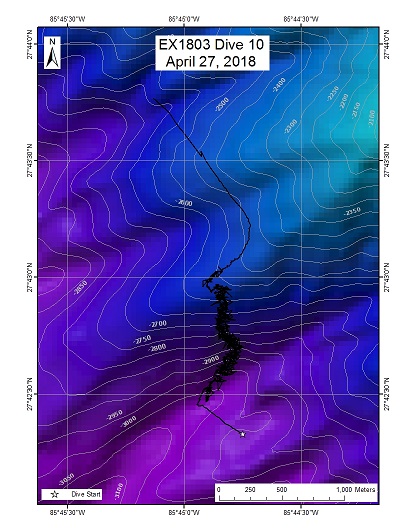
Area
North West Florida Escarpment, DeSoto Canyon region (DC862); Gulf of Mexico
Overview
| Date: | April 27, 2018 |
| Max Depth: | 3010 Meters |
| Bottom Time: | 6 Hours 52 Minutes 55 Seconds |
Purpose
The purpose of Dive 10 was to survey the biology and geology of the bend in the West Florida Escarpment. This area is completely unexplored, with the closest historical dive being conducted close to 39 km away. Additionally, this dive will targeted deeper depths (2400-2800 m), which have been particularly poorly explored in the Gulf of Mexico. Of the 118 scientific submersible dives that have targeted the West Florida Escarpment since 1986, only 5 (4%) have targeted depths deeper than 2400 m. Thus, Dive 10 not only explored a geographically poorly explored area of the Gulf of Mexico, but also a deeper depth range that has only marginally been explored.
Download & View Files
| Dive Summary Report (PDF - 1.14 MB) | View/Download | Requires Adobe Acrobat Reader to view the Dive Summary Report |
| Dive Track (KML - 68.4 KB) | View/Download | Requires Google Earth or equivalent client to view the Dive Track |
| ROV Ancillary Data (Zip - 4.99 MB) | Download | Link takes you to a public FTP server |
| ROV CTD/Sensor Data (Zip - 7.22 MB) | Download | Link takes you to a public FTP server |
| Camera Platform Sensor Data (Zip - 22.1 MB) | Download | Link takes you to a public FTP server |
| Low-Resolution Video Clips (Zip - 15.3 GB) | Download | Link takes you to a public FTP server |
| Underwater Still Images (Zip - 117 MB) | Download | Link takes you to a public FTP server |
| Dive Video Collection Self-Service Portal | Open | Link takes you to an online video discovery and access tool |
South of Long Mound
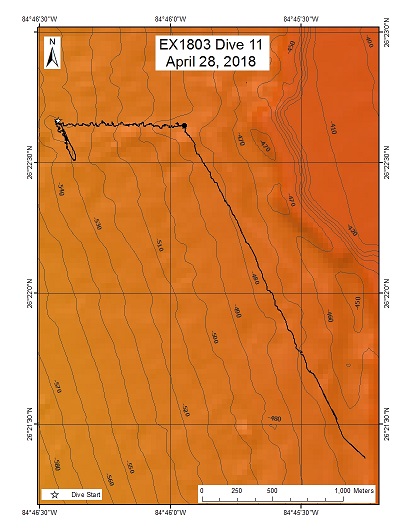
Area
South of Long Mound; Gulf of Mexico
Overview
| Date: | April 28, 2018 |
| Max Depth: | 535 Meters |
| Bottom Time: | 6 Hours 41 Minutes 58 Seconds |
Purpose
The purpose of Dive 11 was to survey the biology of coral mounds in a site that is located between two areas that are currently being considered for the establishment of new habitat areas of particular concern (HAPC) by the Gulf of Mexico Fishery Management Council, Long Mounds and Many Mounds. Both Long Mounds and Many Mounds have been previously surveyed by submersibles, and those dives documented extensive reef-building corals (Lophelia pertusa) at depths between 400-600 m. However, the area located between Long Mounds and Many Mounds has never been surveyed, and is thought to contain similar habitats. This dive also included the first midwater transects of the expedition, which would be carried out as the ROV ascended at the end of the dive. These transects, each 10 min in duration, would target the following depths: 10 m above seafloor, 400 m, 300 m. Four to six replicate transects would be conducted at each depth depending on the remaining bottom time.
Download & View Files
| Dive Summary Report (PDF - 1.28 MB) | View/Download | Requires Adobe Acrobat Reader to view the Dive Summary Report |
| Dive Track (KML - 67.2 KB) | View/Download | Requires Google Earth or equivalent client to view the Dive Track |
| ROV Ancillary Data (Zip - 4.81 MB) | Download | Link takes you to a public FTP server |
| ROV CTD/Sensor Data (Zip - 7.18 MB) | Download | Link takes you to a public FTP server |
| Camera Platform Sensor Data (Zip - 21.1 MB) | Download | Link takes you to a public FTP server |
| Low-Resolution Video Clips (Zip - 14.4 GB) | Download | Link takes you to a public FTP server |
| Underwater Still Images (Zip - 300 MB) | Download | Link takes you to a public FTP server |
| Dive Video Collection Self-Service Portal | Open | Link takes you to an online video discovery and access tool |
South of Okeanos Ridge

Area
South of Okeanos Ridge; Gulf of Mexico
Overview
| Date: | April 29, 2018 |
| Max Depth: | 515 Meters |
| Bottom Time: | 7 Hours 2 Minutes 9 Seconds |
Purpose
Dive 12 targeted an area located just south of Okeanos Ridge, a priority area identified by the Gulf of Mexico Fishery Management Council for the potential establishment of a habitat area of particular concern (HAPC) in the future. Four previous dives surveyed Okeanos Ridge with deep-sea submersibles, and documented extensive deep-sea coral habitat. However, all of those previous dives were conducted >5 km to the north. Thus, the target area of Dive 12 was completely unexplored. The purpose of Dive 12 was to survey the biology and geology of a ridge feature at depths between 400-525 m.
Download & View Files
| Dive Summary Report (PDF - 1.38 MB) | View/Download | Requires Adobe Acrobat Reader to view the Dive Summary Report |
| Dive Track (KML - 66.1 KB) | View/Download | Requires Google Earth or equivalent client to view the Dive Track |
| ROV Ancillary Data (Zip - 4.23 MB) | Download | Link takes you to a public FTP server |
| ROV CTD/Sensor Data (Zip - 6.1 MB) | Download | Link takes you to a public FTP server |
| Camera Platform Sensor Data (Zip - 16.7 MB) | Download | Link takes you to a public FTP server |
| Low-Resolution Video Clips (Zip - 12.4 GB) | Download | Link takes you to a public FTP server |
| Underwater Still Images (Zip - 193 MB) | Download | Link takes you to a public FTP server |
| Dive Video Collection Self-Service Portal | Open | Link takes you to an online video discovery and access tool |
Southern West Florida Escarpment Ridge
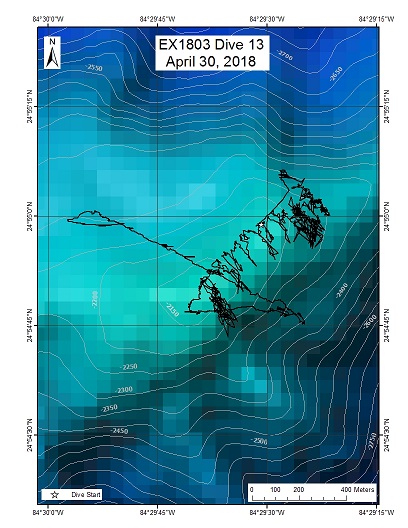
Area
Southern West Florida Escarpment Ridge; Gulf of Mexico
Overview
| Date: | April 20, 2018 |
| Max Depth: | 2240 Meters |
| Bottom Time: | 5 Hours 16 Minutes 32 Seconds |
Purpose
The purpose of Dive 13 was to survey the biology and geology of a ridge feature in the southern end of the West Florida Escarpment at depths between 2100-2250 m. This area is completely unexplored, with the closest historical dive being conducted over 50 km away. Additionally, this area will explore a narrow ridge feature, similar in shape to many ridges surveyed during the CAPSTONE efforts in the Pacific Ocean. Therefore, this dive would also provide insights into how the faunas of these two ocean basins compare to one another in similar environments. Additionally, Dive 13 also included midwater surveys, which were carried out at the end of the dive.
Download & View Files
| Dive Summary Report (PDF - 1.09 MB) | View/Download | Requires Adobe Acrobat Reader to view the Dive Summary Report |
| Dive Track (KML - 68.7 KB) | View/Download | Requires Google Earth or equivalent client to view the Dive Track |
| ROV Ancillary Data (Zip - 4.83 MB) | Download | Link takes you to a public FTP server |
| ROV CTD/Sensor Data (Zip - 7.25 MB) | Download | Link takes you to a public FTP server |
| Camera Platform Sensor Data (Zip - 21.8 MB) | Download | Link takes you to a public FTP server |
| Low-Resolution Video Clips (Zip - 14.2 GB) | Download | Link takes you to a public FTP server |
| Underwater Still Images (Zip - 81.6 MB) | Download | Link takes you to a public FTP server |
| Dive Video Collection Self-Service Portal | Open | Link takes you to an online video discovery and access tool |
Southern West Florida Escarpment Ridge
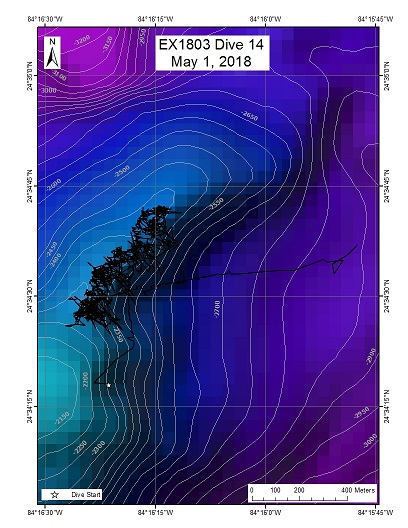
Area
Southern West Florida Escarpment Ridge; Gulf of Mexico
Overview
| Date: | May 01, 2018 |
| Max Depth: | 2366 Meters |
| Bottom Time: | 5 Hours 13 Minutes 58 Seconds |
Purpose
The purpose of Dive 14 was to survey the biology and geology of a narrow ridge feature at depths between 2200-2400 m. This narrow ridge feature is located off a system of canyons on the southern end of the West Florida Escarpment. This area is completely unexplored, with the closest historical dive being conducted over 24 km away. Additionally, this dive explored ridge feature that was similar in shape to many ridges surveyed during the CAPSTONE efforts in the Pacific Ocean. Therefore, this dive would also provide insights into how the faunas of these two ocean basins compare to one another in similar environments.
Download & View Files
| Dive Summary Report (PDF - 1.22 MB) | View/Download | Requires Adobe Acrobat Reader to view the Dive Summary Report |
| Dive Track (KML - 68 KB) | View/Download | Requires Google Earth or equivalent client to view the Dive Track |
| ROV Ancillary Data (Zip - 4.31 MB) | Download | Link takes you to a public FTP server |
| ROV CTD/Sensor Data (Zip - 5.88 MB) | Download | Link takes you to a public FTP server |
| Camera Platform Sensor Data (Zip - 18.4 MB) | Download | Link takes you to a public FTP server |
| Low-Resolution Video Clips (Zip - 11.8 GB) | Download | Link takes you to a public FTP server |
| Underwater Still Images (Zip - 207 MB) | Download | Link takes you to a public FTP server |
| Dive Video Collection Self-Service Portal | Open | Link takes you to an online video discovery and access tool |
Southern West Florida Escarpment Ridge
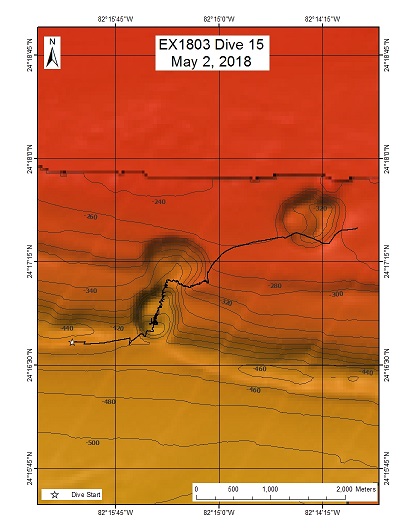
Area
Southern West Florida Escarpment Ridge; Gulf of Mexico
Overview
| Date: | May 02, 2018 |
| Max Depth: | 500 Meters |
| Bottom Time: | 5 Hours 17 Minutes 12 Seconds |
Purpose
Dive 15 targeted a large sinkhole off the Pourtales Terrace. This area is completely unexplored, with the closest historical dive being conducted over 4 km away. Other sinkholes have been surveyed on the Pourtales Terrace, and these are known to host diverse communities of invertebrates and fishes. Additionally, the top of the Pourtales Terrace, which would be surveyed towards the end of the dive, is known to host rich communities of deep-sea corals, invertebrates and other associated fauna.
Download & View Files
| Dive Summary Report (PDF - 1.07 MB) | View/Download | Requires Adobe Acrobat Reader to view the Dive Summary Report |
| Dive Track (KML - 67.6 KB) | View/Download | Requires Google Earth or equivalent client to view the Dive Track |
| ROV Ancillary Data (Zip - 3.88 MB) | Download | Link takes you to a public FTP server |
| ROV CTD/Sensor Data (Zip - 5.91 MB) | Download | Link takes you to a public FTP server |
| Camera Platform Sensor Data (Zip - 16.9 MB) | Download | Link takes you to a public FTP server |
| Low-Resolution Video Clips (Zip - 10.9 GB) | Download | Link takes you to a public FTP server |
| Underwater Still Images (Zip - 127 MB) | Download | Link takes you to a public FTP server |
| Dive Video Collection Self-Service Portal | Open | Link takes you to an online video discovery and access tool |

